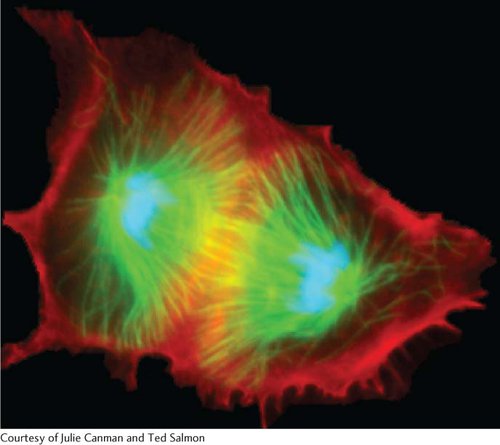2
Chromosomes and Cellular Reproduction
The Blind Men’s Riddle

In a well-
By an interesting coincidence, cells face the same challenge that the blind men do. Most organisms possess two sets of genetic information, one set inherited from each parent. Before cell division, the DNA in each chromosome replicates; after replication, there are two copies—
The solution to the riddle is simple. Socks are sold as pairs; the two socks of a pair are typically connected by a thread. As a pair is removed from the bag, the men each grasp a different sock of the pair and pull in opposite directions. When the socks are pulled tight, one of the men can take a pocket knife and cut the thread connecting the pair. Each man then deposits his single sock in his own bag. At the end of the process, each man’s bag will contain exactly two black socks, two blue socks, two gray socks, two brown socks, and two green socks.1
Remarkably, cells employ a similar solution for separating their chromosomes into new daughter cells. As we will learn in this chapter, the replicated chromosomes line up at the center of a cell undergoing division and, like the socks in the riddle, the sister chromatids of each chromosome are pulled in opposite directions. Like the thread connecting two socks of a pair, a molecule called cohesin holds the sister chromatids together until it is severed by a molecular knife called separase. The two resulting chromosomes separate and the cell divides, ensuring that a complete set of chromosomes is deposited in each cell.
In this analogy, the blind men and cells differ in one critical regard: if the blind men make a mistake, one man ends up with an extra sock and the other is a sock short, but no great harm results. The same cannot be said for human cells. Errors in chromosome separation, producing cells with too many or too few chromosomes, are frequently catastrophic, leading to cancer, reproductive failure, or—
This chapter explores the process of cell reproduction and explains how a complete set of genetic information is transmitted to new cells. In prokaryotic cells, reproduction is simple because each cell possesses a single chromosome. In eukaryotic cells, multiple chromosomes must be copied and distributed to each of the new cells, making cell reproduction more complex. Cell division in eukaryotes takes place through mitosis and meiosis, processes that serve as the foundation for much of genetics.
Grasping mitosis and meiosis requires more than simply memorizing the sequences of events that take place in each stage, although these events are important. The key is to understand how genetic information is apportioned in the course of cell reproduction through the dynamic interplay of DNA synthesis, chromosome movement, and cell division. These processes bring about the transmission of genetic information and are the basis of similarities and differences between parents and progeny.